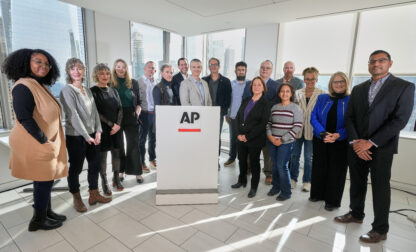Prepared remarks
Gary Pruitt
President and CEO
The Associated Press
News Agencies World Congress
Riyadh, Saudi Arabia
Good morning. I am delighted to be here today to talk about what AP is doing to keep up with changing media markets and customer needs, and I’m looking forward to learning what others are doing in these challenging times for news agencies.
All of us here are constantly being reminded that the news industry is changing – that public appetites for news are changing while new technologies are emerging and disrupting our business models.
As many of our traditional customers suffer revenue declines we feel the ripple effect. As they cut back on resources they need us more than ever but can afford us less.
So, yes, challenging is an accurate word for our situation.
But the question for AP is not do we need to change to survive – that’s a given. It is: how do we need to change?
To help us figure that out, AP commissioned research to see where the problems are — and where the opportunities lie. The result is that we are focusing on growth, both by geography and format.
Research AP commissioned from PQ Media shows that the global market for outsourced news content has declined in real terms by 5 percent since 2008. The global recession of course squeezed advertising revenues further.
What’s encouraging is that PQ Media forecasts the market returning to growth this year, with growth of almost 7 percent by 2017.
Looking beyond this number reveals even more interesting trends within the industry. It won’t surprise you to hear that video is forecast to grow significantly ahead of the rest of the market.
To dig in deeper, we worked with Deloitte to study the consumption of video news. Earlier this year we looked at video consumption in Europe. This week, we’re releasing another chapter of our work with Deloitte: “Liftoff: The new era for video news in Asia.”
The findings are striking.
Among those already online, Asian consumers are more likely than Europeans to discover and share news online. Given the rapid growth of low-cost smartphones and tablets across this region, we believe video offers a way of driving engagement and growth.
In particular, our research has shown that tablet owners are more likely than other consumers to watch video regularly as part of their online news consumption.
In developing Asian markets, many consumers are moving online for the first time on a mobile or tablet. As a result, they feel more comfortable accessing online news from those devices than their peers in more developed markets, where smart-device adoption has happened less rapidly.
So, going forward, AP will be focusing its resources on video, in the critical geographic areas of growth that we have identified: Asia, the Middle East and Latin America.
The most significant step we have taken to deal with these new opportunities has been a project we called the Video Business Transformation.
This required a significant investment to change the way we gather, produce and distribute video to customers. It has involved a series of upgrades, including the rollout of HD cameras across the world, upgraded mobile satellite trucks, greatly enhanced live capabilities and improved capabilities to handle the HD signal.
In addition, our video news bureaus around the globe have been upgraded with the latest generation of video editing, compression and transmission technologies.
State-of-the-art HD Master Control Rooms (MCRs) have been constructed in more than 20 locations including London, New York and Washington. AP’s production systems in New York and Washington have been upgraded for HD production. In London, AP has installed a new production system allowing journalists to edit HD content at their desktops.
During the 18-month project, a cross-disciplinary team rebuilt AP’s video infrastructure, developed new delivery portals, created new workflows and trained staff to use new equipment and tell stories in new ways that respond to customer and market needs.
We also recognized that new kinds of professional news video customers need different solutions.
Many new broadcasters and online customers just do not have the huge broadcast production infrastructures and big roof-top satellites dishes that are so typical of older broadcasters. They need a different way of accessing our breaking news video.
So we launched a pioneering digital self-service platform, the AP Video Hub, which allows customers to download and edit video on their desktop without the costly infrastructure usually required.
The AP Video Hub, now rolled out worldwide, has opened up our video to customers that need it but who couldn’t have accessed it without the changes and investment that we’ve made.
You’ll now see our traditional print customers – newspapers like The New York Times, The Wall Street Journal, The Daily Telegraph – using our breaking news video on their websites every day along with our text, photos and graphics.
Like other news agencies here, our long history is an asset. AP’s own video archive stretches back more than a century and includes more than 1.3 million news stories.
The final piece of our Video Business Transformation that I mentioned earlier was to digitize that archive and to launch a state-of-the-art platform to allow our customers to access it at the click of a mouse.
As we’re here in the Middle East, it seems fitting to tell you about a new product relevant to this region.
Today, we will be announcing the launch of AP Instant Middle East Archive — an online video archive of all of our historic and current stories from or about the Middle East and North Africa that gives our customers unlimited use of the video on a simple subscription basis.
It’s a great example of using new technologies to help revolutionize our business and directly address changing markets and new customer needs.
Social media, too, is helping AP keep up with these changes in our markets.
While some worry that social media is a weapon that could replace news agencies, we believe it’s a critical tool for our survival and success. We have found it helps expand our reach, bring attention to our coverage and raise our brand profile.
One way we use it is to constantly monitor social media for news, photos and video. In a parallel track, we’ve developed a robust and tough in-house process to authenticate this user-generated content.
Earlier this year, we joined forces with a company called Bambuser — a video service that allows users to broadcast, share and watch live video.
Combined with our strict authentication process, this arrangement allows AP to source and stream live verified video news from eyewitnesses around the world. That has allowed us to provide much deeper and broader news than we otherwise could.
Increasingly, we are also customizing and curating our news for individual markets and customers.
We feel it is imperative to move beyond the “wire era” of one-size-fits-all news feeds and build our business around a portfolio of products that responds to the changing needs of our existing customers as well as to new opportunities and new customers.
AP was founded as a result of the disruptive impact of a new technology: the telegraph. Suddenly, the public wanted to know the most important stories from all over the world. And they wanted it quickly.
So, 167 years ago, a small group of newspapers in New York joined forces to get news of the Mexican-American war to their readers more quickly and efficiently, forming The Associated Press.
In the time since then, the news agency business has seen many further shifts: from text to photo and video, the birth of national newspapers, media empires, radio, then TV and, of course, the rise of the Internet and digital media.
The exciting thing about our situation today is that it takes us back to those roots, where our success was, and will be, determined not just by how well we cover the story, but by how well we adapt to the changing needs of customers and consumers of news.
As we do this, however, I want to emphasize that AP will remain true to the principles that have always guided us: accuracy, fairness and a commitment to free speech and holding government and authority accountable.
Our long-standing values are key to our survival every bit as much as adapting to new markets and changing customer needs. For AP, being an independent and not-for-profit news organization whose sole product is the news has proven indispensable.
While news agencies are in a challenging situation today, we are also in a uniquely positive situation.
We have an advantage in that we don’t have to rely on a newspaper or broadcast channel or a format that may come under economic strain and distress. We can adjust as the market adjusts. That’s what AP has done for 167 years.
We will keep evolving. It’s challenging, but I wouldn’t want to change places.



